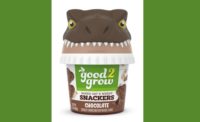Consumers frequently search for fruit inclusions when reaching for bakery goods and snacks. However, in addition to fruity flavor, they’re often shopping for new and novel ingredients, reduced sugar content, and other characteristics that can be a challenge for producers to deliver.
To learn more about trends and tricks around incorporating fruit into bakery and snack products, Snack Food & Wholesale Bakery touched base with Thom King, CEO and chief food scientist with Icon Foods.
Jenni Spinner: Could you please talk about some of the consumer trends around fruit (inclusions, flavor, etc) in baked goods and snacks? Feel free to bring in different flavors, and other concerns like sugar reduction and BFY concerns that might impact how fruit is used in the products they’re buying.
Thom King: While fruit is often perceived as a healthy and natural choice, its natural sugar content can pose challenges to health-conscious consumers. Additionally, some fruits require added sweet ingredients (traditionally sugar) to overcome tartness. Even in desserts and other sweet baked goods like muffins where consumers expect added sugar, many are looking for better-for-you options that deliver indulgence they can feel good about. Reducing sugar continues to be a top priority for buyers: if the total sugar on the Nutrition Facts Panel is too high, they may be dissuaded from purchasing.
On the flavor front, there's a noticeable shift towards exotic fruit flavors like dragon fruit, passion fruit, and guava, particularly with younger generations. Gen Zs like to mix it up with something different. There's also been an increase in combinations that mix sweet with savory, spicy, and umami flavors, such as peach habanero, pineapple Carolina Reaper, mango tamari, and more, particularly in snack mixes.
JS: What challenges do producers face in delivering products that deliver on all of these promises? Is it challenging to balance all of these desires?
TK: Producers must balance consumer nutritional considerations, including sugar reduction, with meeting expectations for innovative and flavorful fruit products. Fruit increases total sugar in your product, but sugar also plays a functional role in baked goods–volume, participation in Maillard, etc.–that must be addressed if you are reducing or replacing it. Fruit also elevates water activity in baked goods, which can greatly diminish shelf life and run the risk of mold. But it’s a challenge with several solutions: from inclusions that deliver fruit flavor and drive down water activity, to natural sweeteners that can help producers create fruit-forward baked goods and snacks with less sugar that still deliver a sweet taste and the needed functionality.
JS: Then, can you talk about how market conditions might be impacting how producers are able to incorporate fruit and fruit flavors in products? i.e. poor crops of certain fruits in recent years, inflation driving up costs of inclusion, etc.?
TK: Fluctuating fruit prices, driven by a variety of factors such as poor crops and environmental changes, present another challenge for producers. For instance, the cost of blueberries might surge from $6 to $9 per pound between years. Inflation exacerbates this, as rising costs across the supply chain squeeze profit margins for producers. This can drastically change your cost of goods sold (COGS). Producers may need to explore alternative fruit options or adjust product formulations by reducing the amount of fruit to mitigate cost instability.
![]() JS: Please talk about some products and formulation strategies that might help producers deliver the fruit flavor consumers want without breaking the bank, elevating sugar content on the Nutrition Facts label, etc.
JS: Please talk about some products and formulation strategies that might help producers deliver the fruit flavor consumers want without breaking the bank, elevating sugar content on the Nutrition Facts label, etc.
TK: Manufacturers can offset sugar on the NFP from fruit inclusions and fillings by decreasing added sugar in the fruit prep, fruit filling, and/or the overall formula by using a non-nutritive sweetener like allulose or erythritol, or a combination of fibers with high-intensity sweeteners such as stevia or monk fruit. With the latter, you get a double effect of not only dropping your net carb impact but also having a fiber count show up on the NFP. For example, in a cranberry orange muffin, there could be upwards of 15 grams of added sugar used purely to sweeten the cranberries so they aren’t overly tart. Even in sweet baked goods without fruit, about 12% of the total formula is some sort of sweetener, and in most of those cases, it's sugar. Gen Z and Millennials especially are looking to cut back on added sugars. When they look at the ingredient deck and the NFP and see those added sugars, it’s going to impact their buying decision.
To address shelf life in baked goods with fruit, producers can use ingredients that decrease water activity. For example, moist blueberry muffins are delicious but can have a short shelf life, unless they’re loaded with preservatives. Using fruit-flavored inclusions that are designed to decrease water activity and soften applications in conjunction with real blueberries can drive down water activity and stabilize your COGS.
In pies, bakers have traditionally used cornstarch in fruit prep to achieve a thick fruit filling and avoid the dreaded soggy pie bottom. But starches add carbohydrates and can raise blood sugar levels. As an alternative, producers can use a digestive-resistant maltodextrin. Also known as soluble tapioca fiber, it’s made from cassava root and has very similar gelling properties to corn starch but it shows up on the Nutritional Facts Panel as an added fiber. And it can be labeled as “cassava root fiber” on the ingredient list to enhance appeal with consumers looking for more recognizable ingredients and a clean label.
JS: Can you talk about some of the products and services Icon Foods provides to help producers with fruit-filled and -flavored items?
TK: We specialize in clean-label sugar reduction solutions offering a range of natural sweeteners like allulose, erythritol, stevia and monk fruit; sweetness modifiers and fibers. Often it’s a combination of these ingredients that deliver the best results for taste, texture, and visual appeal.
Icon Foods’ Flavor Bitz inclusions are small morsels (about 5mm) made with stevia, erythritol, fibers, and natural flavors available in natural Mint Chocolate, Strawberry, Peach, Blueberry and Cinnamon Dolce flavors. They are formulated to drive down water activity, extending shelf life. Flavor Bitz soften applications creating pockets of concentrated flavor in a variety of baked goods like bars, muffins, cookies, and cupcakes. They can be used alone or in combination with real fruit (such as blueberry muffins, strawberry cupcakes, peach cobbler, and more) to decrease the fruit needed, stabilizing COGS and reducing added sugar. For example, the Cinnamon Dolce Flavor Bitz can be added to raisin bread to decrease the amount of raisins needed and amplify a cinnamon raisin flavor, at the same time reducing the added sugar and extending shelf life.
JS: Is there anything you’d like to add?
TK: Producers don’t need to cut out fruit completely: just reduce it. Cutting half of the fruit in a formulation can significantly extend shelf life, drive down your COGS, and reduce sugar, making a product that appeals to today’s health-aware consumer.
Our R&D team works with producers on new baked goods and snack products, as well as reformulations, to get the right levels of sweeteners, inclusions, and real fruit. We have many 1:1 sweetener blends to replace sugar and are constantly innovating with new offerings. We also work with producers to customize sweetener blends to meet their specific needs.





